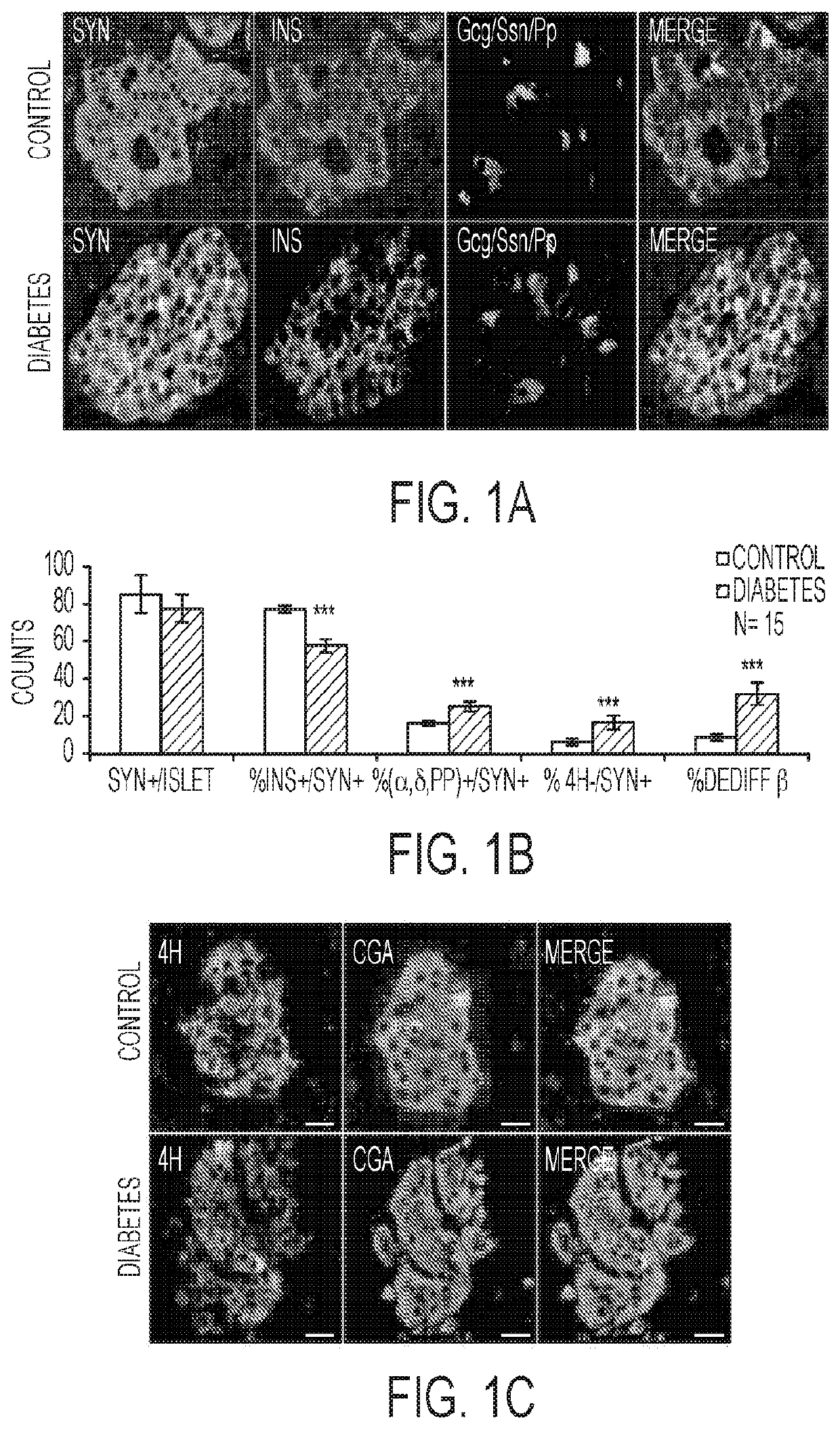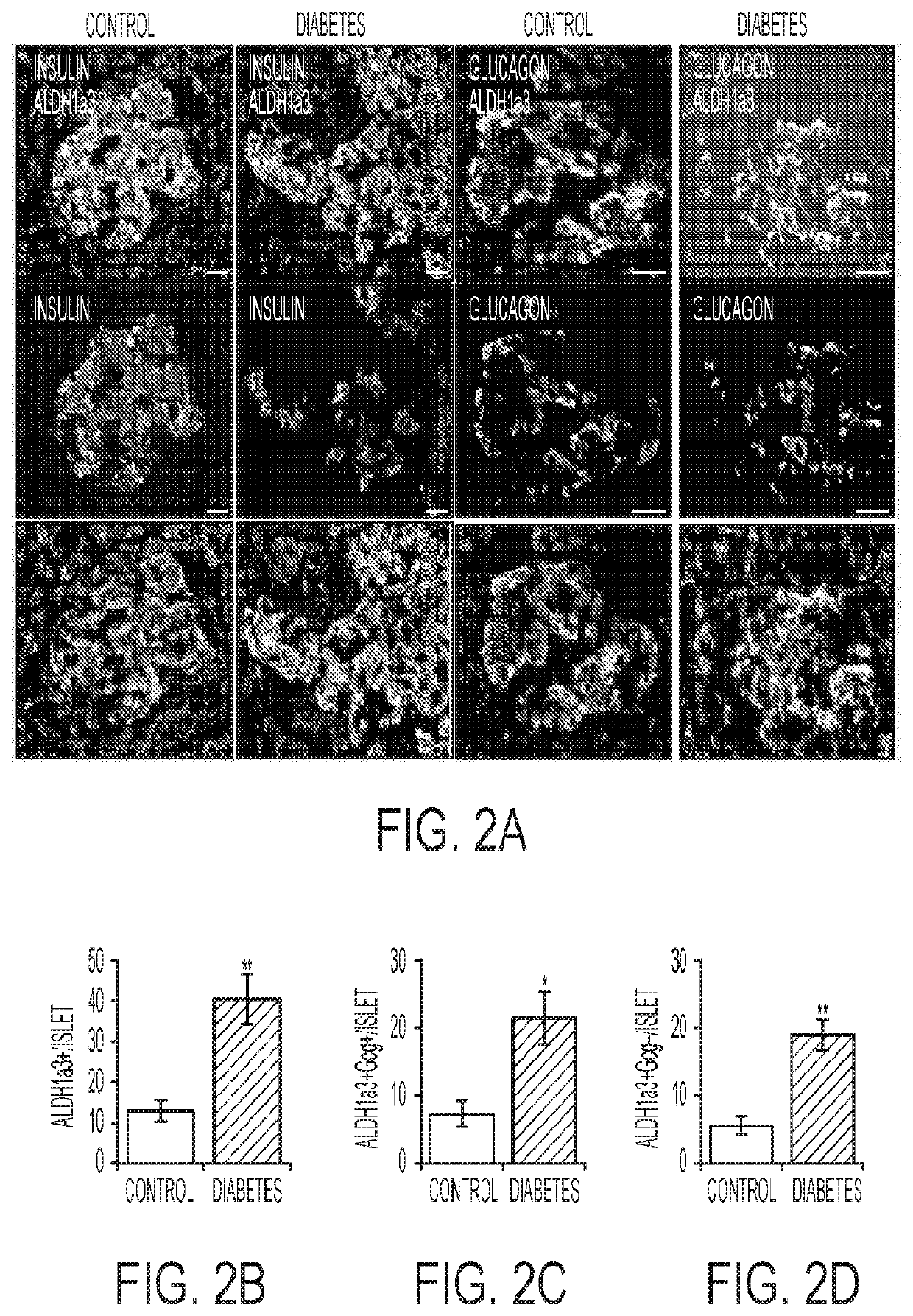Use of aldehyde dehydrogenase as biomarker for beta-cell dysfunction and loss
a beta-cell and biomarker technology, applied in the field of beta-cell dysfunction and loss biomarkers, can solve the problems of stalling protein translation and reducing atp production, and achieve the effect of reducing expression and low levels of aldh1a3
- Summary
- Abstract
- Description
- Claims
- Application Information
AI Technical Summary
Problems solved by technology
Method used
Image
Examples
example 1
nd Materials
[0108]Subjects
[0109]Pancreata were obtained from thirty diabetic organ donors. A summary of baseline characteristics of organ donors is reported in Table 1. Thirteen had a history of type 2 diabetes, one of drug-induced diabetes, and one of diabetes of unclear type. The fifteen controls were organ donors without a history of diabetes, with normal plasma glucose during their stay in the intensive care unit. Their features are reported in Table 2. The institutional review boards at Columbia University and at the University of Pisa have approved all procedures.
[0110]
TABLE 1Baseline Characteristics of Organ DonorsVariableControlDiabetesPNumber1515NSGender (M / F)9 / 67 / 8NSAge56 ± 18 66 ± 17NSBMI (kg / m2)26 ± 6 29 ± 6NSDuration or diabetesN / A12 ± 8N / AWe present data as means ± SD.We analyzed differences using Student's test.
[0111]
TABLE 2Summary of the features of dedifferentiated endocrine cells in type 2diabetesMarkerβ-cellDedifferentiated cellConverted cellα-cellInsulin✓−−−Gluca...
example 2
[0127]Pancreata from Cadaverous Human Type 2 Diabetes Donors Show Increased β-Cell Dedifferentiation
[0128]Dedifferentiation in human pancreata from organ donors with and without diabetes was assessed. The head and neck of the pancreas were surveyed (Wang et al., 2013). Insulin-producing hormone-positive cells were scored using antibodies to insulin, glucagon (Gcg), somatostatin (Ssn), or pancreatic polypeptide (PP), and general endocrine cells were identified using antibodies to synaptophysin (Syn) (Talchai et al., 2012). In a subset of patients (n=5 for each group), the ratios of β-cells and α-cells were reexamined. A 32% decrease (from 77 to 53%) of insulin-positive cells was measured in diabetic human donors (P<1×10−6), and a 68% increase of glucagon-positive cells (from 22% to 37%) (P=0.009) was seen, leading to a rise of the α / β cell ratio from 33% to 63% (P=0.0002) (FIG. 1A-C). In the complete cohort (n= 15 for each group), there were no differences in the number of Syn-positi...
example 3
[0130]The Progenitor Cell Marker Aldehyde Dehydrogenase 1A3 (ALDH1A3) is Dramatically Increased in Dedifferentiated Insulin-Negative Human Islet Endocrine Cells
[0131]A key feature of β-cell dedifferentiation in animal models is regression to a progenitor-like stage (Talchai et al., 2012; Taylor et al., 2013; Wang et al., 2014). As described above, analyses of gene expression datasets in diabetic mice indicated that progenitor cell marker, aldehyde dehydrogenase 1A3 (ALDH1A3) (Marcato et al., 2011), is enriched in dedifferentiated islet endocrine cells. Thus, ALDH1A3 immunoreactivity was used to interrogate human pancreata to identify dedifferentiated β cells.
[0132]Within the ALDH1 family, ALDH1A3 is the major isoform expressed in normal mouse pancreatic islets (FIG. 6B). Notably, ALDH1A3 but not ALDH1A1 was consistently increased in several β-cell stress models, including aging, diet-induced obese (DIO) animals, as well as db / db mice, a widely used model of obesity and diabetes with...
PUM
| Property | Measurement | Unit |
|---|---|---|
| molecular weight | aaaaa | aaaaa |
| molecular weight | aaaaa | aaaaa |
| molecular weight | aaaaa | aaaaa |
Abstract
Description
Claims
Application Information
 Login to view more
Login to view more - R&D Engineer
- R&D Manager
- IP Professional
- Industry Leading Data Capabilities
- Powerful AI technology
- Patent DNA Extraction
Browse by: Latest US Patents, China's latest patents, Technical Efficacy Thesaurus, Application Domain, Technology Topic.
© 2024 PatSnap. All rights reserved.Legal|Privacy policy|Modern Slavery Act Transparency Statement|Sitemap



